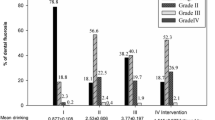Abstract
Endemic fluorosis was detected in 31 villages in the Dhar district of Madhya Pradesh, Central India. Out of the 109 drinking water sources that were analyzed, about 67 % were found to contain high concentration of fluoride above the permissible level of 1.0 mg/l. Dental fluorosis among the primary school children in the age between 8 and 15 served as primary indicator for fluoride intoxication among the children. Urinary fluoride levels among the adults were found to be correlated with drinking water fluoride in 10 villages affected by fluoride. Intervention in the form of alternate safe water supply in five villages showed significant reduction in the urinary fluoride concentration when compared to the control village. Urinary fluoride serves as an excellent marker for assessing the effectiveness of intervention program in the fluoride-affected villages.

Similar content being viewed by others
References
Bailey, K., Chilton, J., Dahl, E., Lennon, M., & Jackson, P. (2006). Fluoride in drinking water. WHO drinking water series. London: IWA.
Cooper, C., Wickham, C. A. C., Barker, D. J. R., & Jacobsen, S. J. (1991). Water fluoridation and hip fracture. Journal of the American Medical Association, 266, 513–514.
CPCB. (1999). Water quality status and statistics 1996–97. New Delhi: Central Pollution Control Board.
Fewtrell, L., Stuart, S., Dave, K., & Bartram, J. (2006). An attempt to estimate the global burden of disease due to fluoride in drinking water. Journal of Water and Health, 4(4), 533–542.
Forte, D. S., Moimaz, S. D. S., & Sampaio, F. A. (2008). Urinary fluoride excretion in children exposed to fluoride toothpaste and to different water fluoride levels in a tropical area of Brazil. Brazilian Dental Journal, 19(3), 214–218.
Handa, B. K. (1984). Water quality and water pollution problem in the Indian sub-continent. IAHS-IASH Publications, 150, 313–322.
Ketley, C. E., & Lenon, M. E. (2001). Determination of fluoride intake from urinary fluoride excretion data in children drinking fluoridated school milk. Caries Research, 35, 252–257.
Kolesnik, A. G., & Pakhomov, G. N. (1997). Annual and biannual monitoring of fluoride intake with 2.5 ppm milk by its excretion in urine in Russian children. Caries Research, 31, 303.
Kondali, V. R. R., Krishnamachari, K. A. V. R., & Gowrinathsastry, J. (1994). Detrimental effects of high fluoride concentrations in drinking water on teeth in an endemic fluorosis area in Southern India. Tropical Doctor, 24, 136–137.
Marthaler, T. M., Marthaler, T. M., Binder-Fuchs, Baez, R. J., & Menghini, G. (2000). Urinary fluoride excretion aged 3 and 4 year old consuming fluoridated domestic salt. Acta Medicine Dental Health, 5, 89–97.
Rakash, K., Singh, R. D., & Sharma, K. D. (2005). Water Resources in India. Current Science, 89, 794–811.
Srikanth, R. (2009). Challenges of sustainable water quality management in rural India. Current Science, 97(3), 317–324.
Srikanth, R., Khanam, A., & Rao, A. M. M. (1994). Fluoride in bore well in selected villages of Medak district, Andhra Pradesh, India. Fluoride, 1994, 27,93–96.
Srikanth, R., Vishawanath, K. S., Khasai, F., & Asmallash, M. (2002). Fluoride in ground water in selected villages in Eritrea. Environmental Monitoring and Assessment, 75(2), 169–77.
Srikanth, R., Tripathi, R. M., & Ravikumar, B. (2008). Endemic fluorosis in Five villages of the Palamau district, Jharkand, India. Fluoride, 41(3), 2006–211.
Susheela, A.K., & Majumdar, K. (1992) Fluorosis control programme in India. Water, Environment and Management: 18th WEDC conference, Katmandu, Nepal (pp. 229–233).
The National Institute for Occupational Safety and Health (NIOSH) (1994). Manual of analytical method. Fluoride in urine. Method, 8308(2), 2–4.
Wang, W. J., Bian, W. J., Bian, Y. J., & Philips, P. C. (1997). Urinary fluoride excretion monitoring: assessment of fluoride intake by Chinese children consuming fluoridated milk (abstract 69). Caries Research, 31, 303.
WHO (2003) Guideline for drinking water quality. Geneva: WHO.
Author information
Authors and Affiliations
Corresponding author
Rights and permissions
About this article
Cite this article
Srikanth, R., Gautam, A., Jaiswal, S.C. et al. Urinary fluoride as a monitoring tool for assessing successful intervention in the provision of safe drinking water supply in five fluoride-affected villages in Dhar district, Madhya Pradesh, India. Environ Monit Assess 185, 2343–2350 (2013). https://doi.org/10.1007/s10661-012-2713-y
Received:
Accepted:
Published:
Issue Date:
DOI: https://doi.org/10.1007/s10661-012-2713-y




